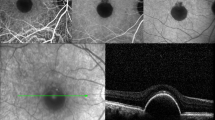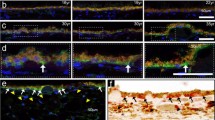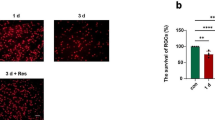Abstract
Background
Neuron-specific enolase and S100 protein are markers of neuronal lysis. To assess the neuronal suffering in rhegmatogenous retinal detachment we quantified neuron-specific enolase and S100 protein in the subretinal fluid.
Methods
The puncture was performed in the sclera with a Merseture 5/0 round needle, and the fluid was collected with a glass capillary tube. Twelve subretinal fluid samples were obtained from 12 eyes with rhegmatogenous retinal detachment undergoing retinal detachment surgery. Vitreous from ten eyes with macular hole or epimacular membrane served as negative control group, and vitreous collected during cornea procurement from ten deceased patients served as positive control group.
Results
The mean concentration of neuron-specific enolase (in nanogrammes per millilitre) was 602 in the subretinal fluid of rhegmatogenous retinal detachment, 10.2 in the serum of these patients, 2.9 in the vitreous of the negative control group, and 364 in the positive control group. The mean concentration of S100 protein (in nanogrammes per millilitre) was 104 in the subretinal fluid of rhegmatogenous retinal detachment, <0.1 in the serum of these patients and in the vitreous of the control negative group, and 11.18 in the positive control group.
Conclusion
Neuron-specific enolase (NSE) and S100 are known to be good markers of brain stress and, thus, are good markers of retinal stress.
Similar content being viewed by others
References
Abraha HD, Butterworth RJ, Bath PM, Wassif WS, Gartwaite J, Sherwood RA (1997) Serum S-100 protein, relationship to clinical outcome in acute stroke. Ann Clin Biochem 34(Pt 5):546–550
Berrod JP, Kayl P, Rozot P, Raspiller A (1993) Proteins in the subretinal fluid. Eur J Ophthalmol 3(3):132–137
Bradfordt MM (1976) A rapid and sensitive method for quantification of microgram quantities of protein utilizing the principle of protein−dye binding. Anal Biochem 72:248–254
Brown K, Kynoch PAM, Thompson RJ (1980) Immunoreactive nervous system specific enolase (14-3-2 protein) in human serum and cerebrospinal fluid. Clin Chim Acta 101(23):257–264
Chignell A, Carruthers M, Rahi H (1971) Clinical, biochemical, and immunoelectrophoretic study of subretinal fluid. Br J Ophthalmol 55:525–532
Cochran AJ, Holland GN, Saxton RE, Damato BE, Foulds WR, Herschman HR, Foos RY, Straatsma BR, Lee WR (1988) Detection and quantification of S-100 protein in ocular tissues and fluids from patients with intraocular melanoma. Br J Ophthalmol 72(11):874–879
Comoy E, Roussat B, Henry I (1990) L’énolase neurospécifique dans l’humeur aqueuse. Intérêt dans le diagnostic différentiel du mélanome. Ophtalmologie 4:233–235
Coquerel A, Loeb A, Proust B, Jeannot E, Fessard C (1989) An index of neuronal lysis: neuron-specific enolase (NSE) in cerebrospinal fluid; diagnostic and prognostic values in newborns and infants. Biologie prospective. In: Galeau MM, Siest G, Henry J (eds) Comptes rendus du 7ème colloque de Pont-à-Mousson. John Libbey Eurotext, Paris, pp 253–256
De Bokay E, Aouididi S, Coquerel A (1995) Subretinal fluid elevation of NSE in patients with retinal detachment. Investig Ophthalmol Vis Sci 36:S7001
Dequen L, Beaudeux J-L, Leger P (1999) Cinétique d’évolution plasmatique de la protéine S-100 au cours des pontages aorto-coronaires utilisant différentes techniques opératoires. Immunol Anal Biol Spec 14:119–124
Ingebrigtsen T, Romner B, Kongstad P, Langbakk B (1995) Increased serum concentrations of protein S-100 after minor head injury: a biochemical serum marker with prognostic value? J Neurol Neurosurg Psychiatry 59(1):103–104
Johnsson P, Lundqvist C, Lindgren A, Ferencz I, Alling C, Stähl E (1995) Cerebral complications after cardiac surgery assessed by S-100 and NSE levels in blood. J Cardiothorac Vasc Anesth 9(6):694–699
Keating Mac EG, Andrews PJ, Mascia L (1998) Relationship of neuron specific enolase and protein S-100 concentrations in systemic and jugular venous serum to injury severity and outcome after traumatic brain injury. Acta Neurochir Suppl (Wien) 71:117–119
Miliotes G, Lyman GH, Cruse CW, Puleo C, Albertini PA, Rapaport D, Glass F, Fenske N, Soriano T, Cuny C, Van Voorhis N, Reintgen D (1996) Evaluation of new putative tumor markers for melanoma. Ann Surg Oncol 3(6):558–563
Mokuno K, Kato K, Kawai K, Matsuoka Y, Yanagi T, Sobue I (1993) Neuron-specific enolase and S-100 protein levels in cerebrospinal fluid of patients with various neurological diseases. J Neurol Sci 60:443–451
Moore BW, Mc Gregor D (1965) Chromatographic and electrophoretic fractionation of soluble proteins of brain and liver. J Biol Chem 240:1647–1653
Nakajima T, Kato K, Kaneko A, Tsumuraya M, Morinaga S, Shimosato Y (1986) High concentrations of enolase, α- and χ-subunits, in the aqueous humor in cases of retinoblastoma. Am J Ophthalmol 101:102–106
Pahlman S, Esscher T, Bergvall P, Odelstad L (1984) Purification and characterization of human neuron-specific enolase: radioimmunoassay development. Tumour Biol 5(2):127–139
Persson L, Härdemark HG, Gustafsson J, Rundström G, Mendel-Hartvig I, Esscher T, Pählman S (1987) S-100 protein and neuronspecific enolase in cerebrospinal fluid and serum: markers of cell damage in human central nervous system. Stroke 18(5):911–918
Scarna H, Delafosse B, Steinberg R, Debilly G, Mandrand B, Keller A, Pujol JF (1982) Neuron-specific enolase as a marker of neuronal lesions during various comas in man. Neurochem Int 4(5):405–411
Schoultz von E, Hansson LO, Djureen E, Hansson J, Kärnell R, Nilsson B, Stigbrand T, Ringborg U (1996) Prognostic value of serum analyses of S-100β protein in malignant melanoma. Melanoma Res 6(2):133–137
Sebag J, Tuyen V, Faure JP, Chauvaud D, Pouliquen Y (1987) Retinal S-antigen in human subretinal fluid. Investig Ophthalmol Vis Sci 28(12):2038–2041
Shine BSF, Hungerford J, Vaghela B, Sheraidah GAK (1990) Electrophoretic assessment of aqueous and serum neurone-specific enolase in retinoblastoma and ocular malignant melanoma. Br J Ophthalmol 74:427–430
Sindic CJ, Chalon MP, Cambiaso CL, Laterre EC, Masson PL (1982) Assessment of damage to the central nervous system by determination of S-100 protein in the cerebrospinal fluid. J Neurol Neurosurg Psychiatry 45:1130–1135
Stefansson K, Wollman RL, Jerkovic M (1982) S100 protein in soft-tissue tumors derived from Schwann cells and melanocytes. Am J Pathol 106(2):261–268
Steinberg R, Gueniau C, Scarna H, Keller A, Worcel M, Pujol JF (1984) Experimental brain ischemia : neuron-specific enolase level in cerebrospinal fluid as an index of neuronal damage. J Neurochem 43(1):19–25
Steinhoff BJ, Tumani H, Otto M, Mursch K, Wiltfang J, Herrendorf G, Bittermmann HJ, Felgenhauser K, Paulus W, Markakis E (1999) Cisternal S100 protein and neuron-specific enolase are elevated and site-specific markers in intractable temporal lobe epilepsy. Epilepsy Res 36(1):75–82
Wiesmann M, Missler U, Gottmann D (1998) Plasma S-100b concentration in healthy adults is age and sex independent. Clin Chem 44:1056–1058
Zimmer DB, Eldik van LJ (1987) Tissue distribution of rat S100α and S100β and S100-binding proteins. Am J Physiol Soc 252(3Pt 1):C285–C289
Author information
Authors and Affiliations
Corresponding author
Rights and permissions
About this article
Cite this article
Quintyn, J.C., Pereira, F., Hellot, M.F. et al. Concentration of neuron-specific enolase and S100 protein in the subretinal fluid of rhegmatogenous retinal detachment. Graefe's Arch Clin Exp Ophthalmo 243, 1167–1174 (2005). https://doi.org/10.1007/s00417-005-1175-0
Received:
Revised:
Accepted:
Published:
Issue Date:
DOI: https://doi.org/10.1007/s00417-005-1175-0




